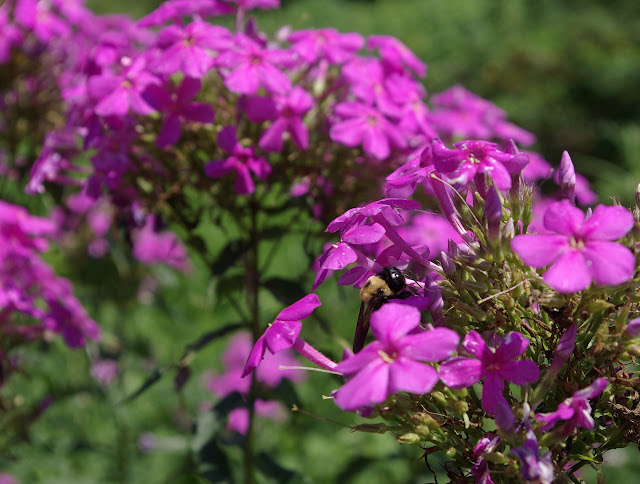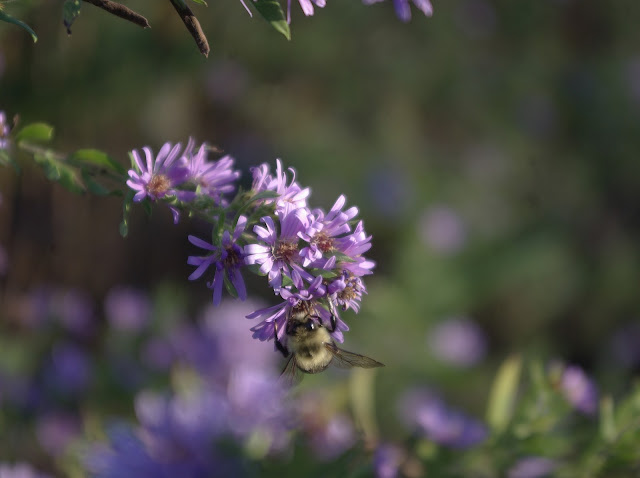The Christmas presents are ordered and the cookies are baked, so I am taking some time to look back at last summer's garden.
I have spread starts of 'Raspberry Wine' all around the garden. It is not appealing to deer or voles, which is a great thing. Most of the pests in my garden started being a problem once I had a lot of something, so it's nice that nothing likes to eat it. It likes a bit of food and requires water in hot dry weather or it looks miserable.
The foliage smells wonderful, especially 'Claire Grace'. Stepping on the rosettes will perfume the immediate area. The plant is called wild bermagot because the fragrance of the leaves is similar to bermagot orange, which is used to flavor Earl and Lady Gray tea and Turkish delight.
Another great plant for fragrance is sweet pepperbush. The fragrance of the flowers is very nice, a little bit like vanilla, and carries, so you don't have to stick your nose in the flowers to get the scent. All of the pepperbush I have grows wild here. There's a big bank of it west of the old house site and all along the big ditch that runs behind the big perennial bed and east of the old house site.

It also grows along waterways elsewhere on the farm.
Sweet pepperbush blooms in July and insects flock to it.
Summer phlox is fragrant too, although I don't find it be very fragrant in the same way that summersweet is; in any case that's fine with me because I'm not sure I love the fragrance anyway. I've noticed that carpenter bees love this plant. I always see a lot of them feeding or just hanging out when I go in and out of the house.
Meadow beauty is another native that blooms during the heat of the summer. It blooms all summer and into fall, as a matter of fact. It's low-growing, less than 6 inches in height, but a mass of these flowers has a lot of impact. This is a group of Virginia meadow beauty that's growing behind the shavings pile. I didn't plant it there, it just appeared. Meadow beauty grows wild here everywhere, from the edge of the woods up above the house to the fields near the creek. I have transplanted a little bit of Maryland meadow beauty (thinner leaves, paler pink flowers than Va. meadow beauty) in the front of the big perennial bed but really should transplant more of both species into the garden.
This is the perfect Hibiscus moscheutos. I grew it from seed, so I wasn't sure what I was going to get, but it's amazing: it's big, rounded, and covered in big pink flowers in the middle of summer. It's a shame that Japanese beetles love them so much. I managed to get a picture before the buggers chewed raggedy holes into the leaves and flowers.
Purple and blue is so cooling in the heat of summer. I grew Stoke's aster from seed sent from the NC Botanical Garden and while the first batch produced flowers of a rather anemic blue, the second batch I grew has beautiful vivid flowers. I have to grow them in pots to protect them from voles.
I wanted powdery thalia after seeing it in a pond in the White Garden at the JC Raulston Arboretum. The flowers are so unique and beautiful, a rich purple with a powdery silver white finish. It's happy in the ditch that runs besides the old house site. Here it is with pickerelweed.
As long as they aren't fooled into blooming too early, we usually get a good crop of wild
blueberries. We had one highbush blueberry (on the left); the rest are Southern black blueberries.

blueberries. We had one highbush blueberry (on the left); the rest are Southern black blueberries.

Veering from the subject of native plants, crape myrtles are a summer staple in the Southeast. They are not dependably winter hardy north of Virginia, but are they ever drought and heat tolerant. I grew a seedling of 'Pink Lace' from a cutting
They are all over the map in terms of habit. One is quite tall and shaped like a columnar shrub. The seedling pictured above is an oval shrub. The seed parent (the 'Pink Lace' seedling) is an actual tree with about a dozen stems, as contradictory as that sounds. My favorite seedling is the one below, as it also has a true tree form. It's more upright in habit than its parent.
Alas, only one of my crape myrtles has any fall color, the shrubby little pink one pictured below on the left. It turned bright orange but even that was fleeting.
Now I know why NC State never introduced that 'Pink Lace' seedling. (In my defense, I didn't realize when I started the cutting that neither 'Pink Lace' nor its seedling has any fall color. I didn't realize there were any crape myrtle cultivars with no fall color.) Now I turn a little bit green whenever I see other people's brilliant orange and red crape myrtles in the fall. I don't want to get rid of the crape myrtles I have, as they're beautiful when they're in bloom
Insects, amphibians, ans reptiles thrive in the heat as much as crape myrtles do. While I am wilting and burning up the butterflies are fluttering around like they're at a party.
There are always a few sulfurs in late summer, culminating in dozens in the fall. They gather in pools of bright yellow in the paddock that shatter when the butterflies are startled. They rise and flutter, and then fall to form pools again.
I'm always amazed by where I see birds' nests in the winter. Many times I've walked right by nests in the summer and wasn't aware of their location until the leaves have fallen. (The parents alarm calling was a sure sign there was a nest nearby somewhere, but I didn't know where.) OTOH, I hear the chipping sparrow babies in one of the pines at the back of the big bed every year. They're so loud it's easy to pinpoint the nest site. Every year the cardinals and mockingbirds nest in the front or side garden. Last year a blue grosbeak nested in one of the rugosas in the front garden.
I know this post isn't very Christmas-y, and that many of us are more interested in getting wrapped up in a blanket than gardening this time of year
but I thought all of the colors might provide a cup of cheer. Here's a Christmas-colored zinnia to end this post.
































































